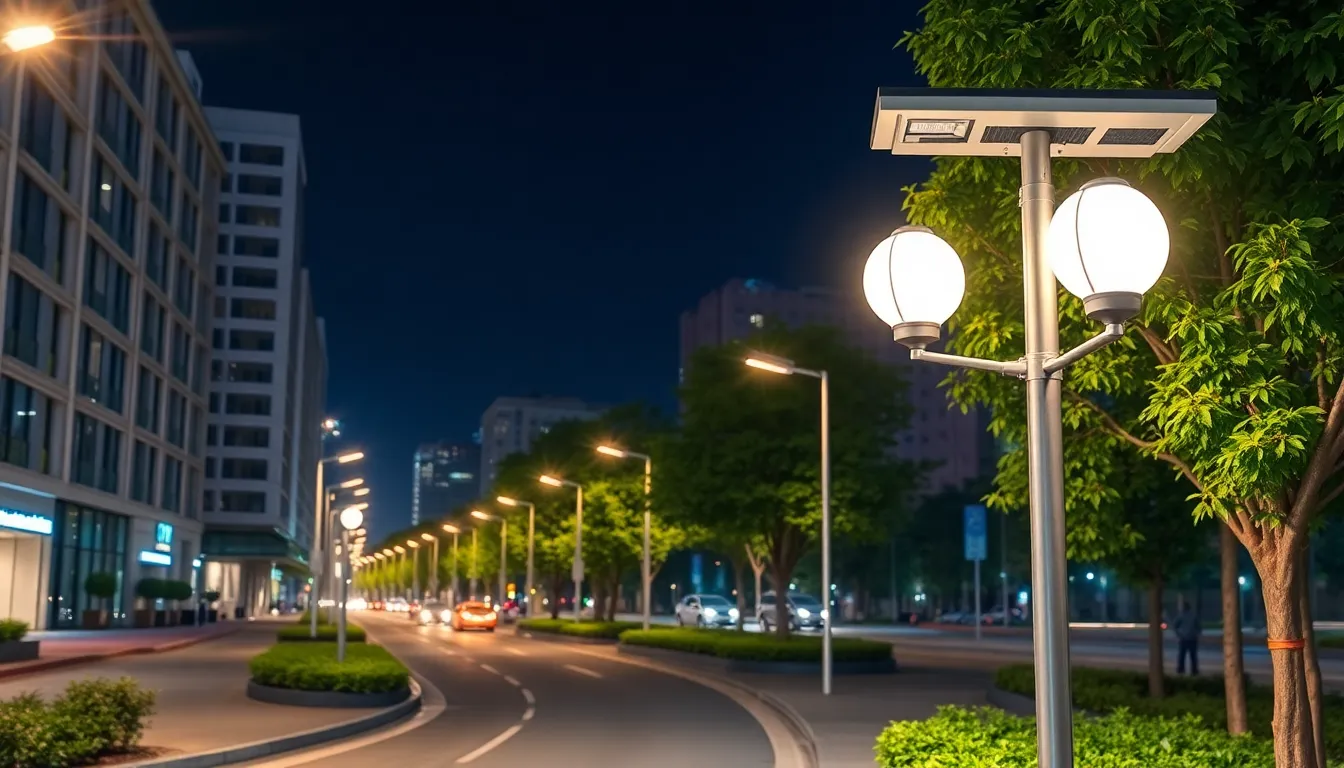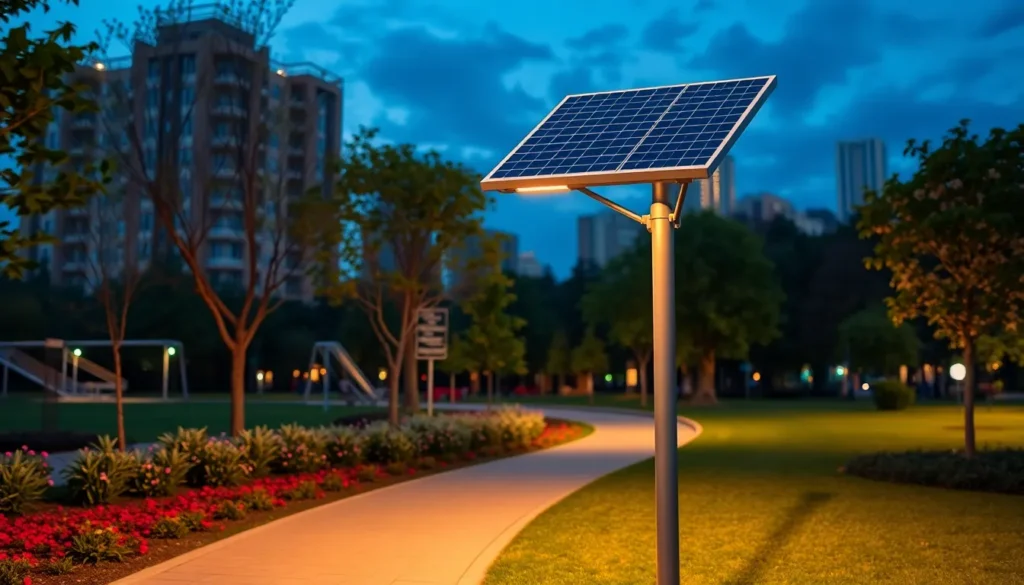Imagine a world where streetlights don’t just flicker on and off like a moody teenager but shine brightly all night long, powered by the sun. Solar street lighting isn’t just a smart choice; it’s a brilliant one. With the ability to harness solar energy, these lights not only save money but also reduce carbon footprints faster than you can say “green energy.”
Gone are the days of tangled wires and hefty electricity bills. Solar street lights bring a touch of modernity and sustainability to urban landscapes, lighting the way for pedestrians and drivers alike. They’re like the superheroes of the night—no capes required! As cities embrace this innovative technology, the benefits keep shining brighter than ever. So, let’s dive into why solar street lighting is the future of illuminating our streets.
Table of Contents
ToggleOverview of Solar Street Lighting
Solar street lighting utilizes solar panels to convert sunlight into electrical energy for illumination. These systems, composed of solar panels, LED lights, batteries, and controllers, operate independently from traditional power sources. Effective in various environments, solar street lights function well in areas without access to electricity, such as remote locations and urban parks.
The benefit of solar street lighting includes reduced operational costs. No electricity bills arise from energy generation, leading to long-term savings. Additionally, these lights require minimal maintenance, as LED technology promotes durability and efficiency.
Environmental impact also plays a crucial role in the appeal of solar street lighting. The technology helps reduce carbon emissions by relying on renewable energy sources. As cities seek sustainable solutions, solar street lights contribute significantly to lowering the carbon footprint associated with urban lighting.
Installation procedures simplify urban planning. Quick to install without the need for extensive wiring or electrical infrastructure, solar street lights offer an efficient option for municipalities. They enhance public safety by providing illumination in typically dark areas, promoting walkability and security.
As communities adopt solar street lighting, aesthetic benefits also arise. Modern designs integrate seamlessly with various architectural styles, improving the visual appeal of public spaces. The transition to solar not only fosters sustainability but also enlivens urban landscapes, bringing life to public areas.
Overall, solar street lighting presents an innovative approach to urban illumination. The intersection of energy efficiency, environmental responsibility, and improved safety makes solar lighting a transformative solution for cities worldwide.
Benefits of Solar Street Lighting

Solar street lighting offers numerous advantages that significantly enhance urban environments. These systems contribute to sustainability, reduce costs, and improve public safety.
Environmental Impact
Solar street lights lower carbon emissions significantly. By using renewable energy, they eliminate dependency on fossil fuels. Less reliance on traditional power grids means fewer greenhouse gases. Areas that install solar lighting can expect improved air quality. Wildlife benefits from reduced light pollution, which promotes healthier ecosystems. These lights operate with minimal ecological disruption, aligning with environmental goals for urban areas.
Cost Savings
Solar street lighting leads to impressive cost savings. Eliminating electricity bills allows cities to allocate funds elsewhere. Initial installation costs can be offset by long-term savings on energy expenses. Maintenance requirements are minimal, thanks to durable LED technology. Over time, cities save on replacement parts and labor. Additionally, solar lights require no extensive wiring, further reducing installation costs. Budget-friendly solutions enhance financial sustainability for municipalities aiming to optimize resources.
Key Components of Solar Street Lighting
The effectiveness of solar street lighting relies on several key components, each playing a critical role in providing reliable illumination.
Solar Panels
Solar panels capture sunlight and convert it into electrical energy. These panels typically consist of photovoltaic cells that generate electricity when exposed to sunlight. They work efficiently during daylight hours, powering the street lights after sunset. The size and quality of solar panels directly impact the energy generated, ensuring adequate lighting in various weather conditions. High-efficiency panels maximize energy output, leading to longer operational hours throughout the night.
LED Lights
LED lights serve as the primary lighting source in solar street lighting systems. They offer superior energy efficiency and longevity compared to traditional bulbs. Brightness levels and color temperature can vary based on community needs and safety standards. LEDs consume less power, enabling longer nighttime illumination without draining the batteries. Their durability also reduces maintenance costs, making them an optimal choice for outdoor applications.
Batteries
Batteries store the energy generated by solar panels for nighttime use. These components come in various types, including lithium-ion and lead-acid options. Battery capacity determines how long street lights remain illuminated after dark. Efficient batteries ensure reliable performance, even during overcast conditions. Proper maintenance and timely replacement extend the lifespan of battery systems, further enhancing the sustainability of solar street lighting solutions.
Installation Considerations
Successful installation of solar street lighting involves careful planning and assessment. Key factors ensure optimal performance and integration with surrounding environments.
Site Assessment
Conducting a thorough site assessment is essential for determining the best locations for solar lights. Evaluating factors such as sunlight exposure, shading from trees or buildings, and existing infrastructure contributes to efficient energy capture. Identifying potential obstacles helps maximize light distribution and ensures visibility at night. Furthermore, analyzing pedestrian and vehicle traffic patterns offers insights into where illumination is most needed.
Design Planning
Focusing on design planning ensures solar street lights meet specific urban requirements. Selecting appropriate pole heights, lighting angles, and LED specifications directly influences performance and effectiveness. Visualization of light distribution helps assess adequacy in illuminated areas. Coordination with local authorities aids in adhering to zoning regulations and aesthetic standards. Integrating smart technology features, such as motion sensors, enhances functionality, allowing energy savings while adjusting brightness according to demand.
Challenges and Solutions
Solar street lighting systems face specific challenges that can impact their effectiveness. Addressing these issues is crucial for maximizing their benefits.
Initial Costs
Initial costs often pose a barrier to the widespread adoption of solar street lighting. While solar lights eliminate electricity bills, upfront investment can be significant. Systems may range from $1,000 to $3,500 per unit, depending on the technology and features. Municipalities sometimes hesitate to allocate these funds, viewing it as a financial strain. Exploring financing options can ease these concerns. Grants and subsidies increase affordability, encouraging cities to transition to solar solutions. Long-term savings also balance the initial costs, making solar street lights an economically wise choice.
Maintenance Issues
Maintenance issues occasionally arise with solar street lighting systems. Although these lights require less upkeep compared to traditional options, components like batteries may need replacement every 3 to 5 years. In urban settings, vandalism can damage fixtures, creating safety concerns. Cities must allocate resources for repairs, which can lead to unplanned expenses. Implementing robust designs can minimize damage and the need for frequent repairs. Regular inspections also ensure system longevity, keeping lights functional. Innovative technologies, such as smart sensors, help monitor performance and inform maintenance needs, further reducing operational challenges.
Future Trends in Solar Street Lighting
Innovative advancements in solar street lighting continue to reshape urban landscapes. Smart technology integration is becoming prevalent, with sensors providing real-time data on ambient light levels and pedestrian movement. Such enhancements increase energy efficiency and ensure adequate illumination depending on environmental conditions.
Increased battery technology efficiency improves solar street lighting systems. Better batteries offer longer storage capabilities, allowing lights to operate effectively even during prolonged cloudy days. This advancement not only extends functionality but also optimizes operational reliability.
Sustainability plays a central role in future trends. As urban areas embrace ambitious carbon neutrality goals, reliance on solar street lighting expands. Cities are adopting these systems due to their low environmental impact and potential to enhance public spaces.
Cost-effective solutions are consistently emerging in the solar street lighting sector. Innovations drive down production costs, making installations more affordable for municipalities. With lower price points, wider adoption becomes feasible, facilitating urban upgrades.
Modular designs are gaining traction, providing flexibility in installation and maintenance. These configurations enable quick upgrades and easier repairs. Optimizing the lifespan of solar street lights while minimizing maintenance complexities is a top priority.
Collaboration with local communities is essential for successful implementation. Engaging citizens in the planning process fosters ownership and satisfaction. Such partnerships ensure solar street lighting meets the specific needs of neighborhoods.
Finally, comprehensive data analysis is becoming a vital component. Collecting data on energy consumption and usage patterns allows municipalities to track performance and optimize energy management. As innovation drives development, solar street lighting positions itself as a leading solution for modern urban illumination challenges.
Solar street lighting represents a forward-thinking solution for urban illumination. By harnessing renewable energy it not only enhances safety but also contributes to environmental sustainability. As cities continue to embrace this technology the benefits become increasingly clear. Reduced energy costs and minimal maintenance requirements make solar street lights a practical choice for municipalities.
The integration of smart technology and improved battery systems promises even greater efficiency and reliability. As communities prioritize greener initiatives solar street lighting will play a crucial role in shaping the future of urban landscapes. Embracing this innovative approach can lead to safer brighter and more eco-friendly cities for everyone.



